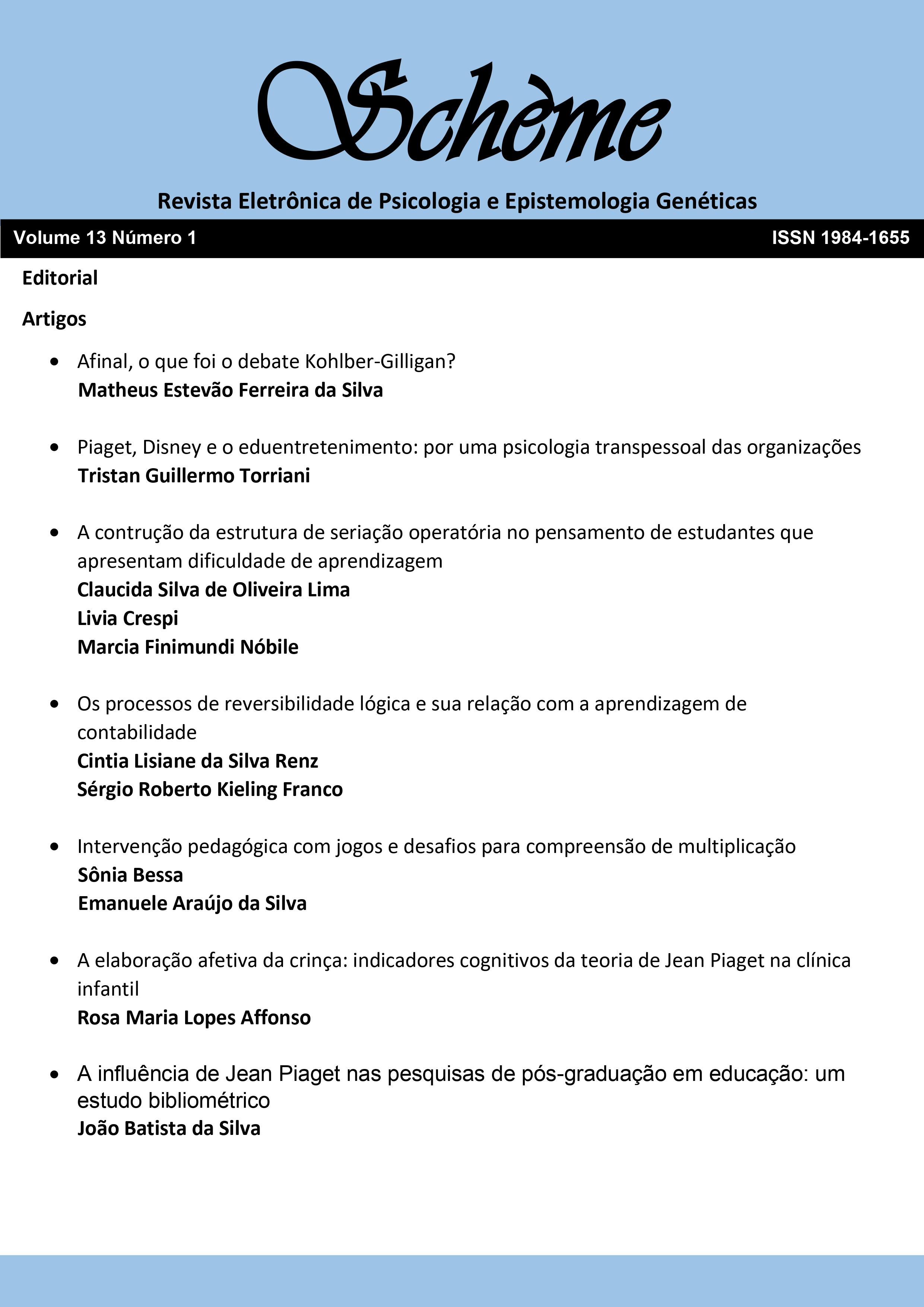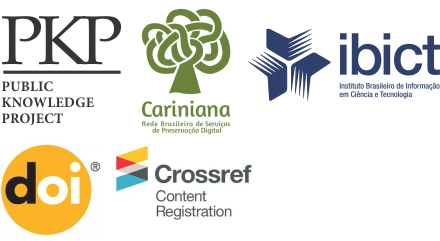PIAGET, DISNEY E O EDUENTRETENIMENTO: POR UMA PSICOLOGIA TRANSPESSOAL DAS ORGANIZAÇÕES
DOI:
https://doi.org/10.36311/1984-1655.2021.v13n1.p41-81Palavras-chave:
Walt Disney, Jean Piaget, Rudolf Steiner, Organização, TaoismoResumo
A Psicologia Transpessoal das Organizações preocupa-se com o desenvolvimento de indivíduos que podem crescer em equilíbrio físico, emocional, intelectual e espiritual ao longo de sua vida. Ela compartilha muitas posições de Piaget sobre equilíbrio dinâmico, sobre adaptação através da assimilação e acomodação, sobre autonomia e sobre a necessidade de respeitar o estágio de desenvolvimento da criança. Também compartilha o interesse de Disney pela literatura infantil e folclore como um caminho para a autodescoberta. Usando teses propostas por R. Steiner, M. P. Hall e os teóricos do Eneagrama, a teoria piagetiana e as suas distinções técnicas são assimiladas para analisar o fenômeno dainfluência global da Disney. É dada especial atenção às questões do adultocentrismo, do etnocentrismo e da apropriação, substituição e banalização comercial multiculturalista das tradições ancestrais. Apesar das melhores intenções de Walt, o eduentretenimento se mostra como uma espada de dois gumes com potencial para fazer mais mal do que bem se os cidadãos forem marginalizados a ponto de não serem mais livres para criticar, boicotar ou de resistir ao conteúdo que lhes for imposto pelos grandes conglomerados midiáticos.
Downloads
Referências
BAUDRILLARD, J. Simulacres et simulation. Paris: Galilée, 1981.
BEAUMONT-THOMAS, B. Disney grandniece backs Meryl Streep on Walt's racism and sexism. The Guardian, London, 16/jan./2014. Disponível em: http://www.theguardian.com/film/2014/jan/16/abigail-disney-merylstreep-racism-sexism. Acesso em: 17 jun. 2020.
BLOCK, J. Assimilation, Accommodation, and the Dynamics of Personality Development. Child Development. v. 53, n. 2, 1982, p. 281–295. JSTOR, www.jstor.org/stable/1128971. Accessed 5 Aug. 2020.
BOVA, A. Adult as a source of expert opinion in child’s argumentation during family mealtime conversations. Journal of Argumentation in Context. v. 4 , n.1, 2015, p. 4-20. Disponível em: http://papers.ssrn.com/sol3/papers.cfm?abstract_id=2414383. Acesso em: 17 jun. 2020.
CHESTNUT, B. The Complete Enneagram: 27 Paths to Greater SelfKnowledge. Berkeley, CA: She Writes Press, 2013.
DORFMAN, A.; MATTELART, A. How to Read Donald Duck. Imperialist Ideology in the Disney Comic. NY: I.G. Editions, 1971.
DOWLING, C. The Cinderella Complex: Women's Hidden Fear of Independence. NY: Summit Books, 1981
ECO, U. Travels in hyperreality. Essays. San Diego, New York, London: Harvest, 1990.
ELKIND, D. Child Development and Education. A Piagetian Perspective. NY: Oxford University Press, 1976.
FERRAIUOLO, P. Disney and the Bible. A Scriptural Critique of the Magic Kingdom. Camp Hill (PA), USA: Horizon Books, 1996.
FOGLESONG, R. E. Married to the Mouse: Walt Disney World and Orlando. New Haven: Yale University Press, 2001.
FURTH, H. G. Concerning Piaget's View on Thinking and Symbol Formation. Child Development, v. 38, n. 3, p. 819-826, September 1967. Disponível em: http://www.jstor.org/stable/1127258 Acesso em: 17 jun 2020.
GIROUX, H. A. The Mouse That Roared: Disney and the End of Innocence. NY: Rowman & Littlefield, 1999.
HABERMAS, J. Theorie des kommunikativen Handelns. v. 2: Zur Kritik der funktionalistischen Vernunft. Frankfurt am Main: Suhrkamp, 1981.
HALL, M. P. The Secret History of America: Classic Writings on Our Nation's Unknown Past and Inner Purpose. Los Angeles (CA), USA: Philosophical Research Society, 1944.
HANSEN, M. Of Mice and Ducks: Benjamin and Adorno on Disney. South Atlantic Quarterly , v. 92, n.1, Winter 1993, p. 27-61.
HIAASEN, C. Team Rodent: How Disney Devours the World. NY: Random House, 1998.
HUNT, S. W. 'Frozen' Director Apologizes to Parents for "Let It Go". The Hollywood Reporter, 12/dez./2014. Disponível em: http://www.hollywoodreporter.com/news/frozen-director-apologizesparents-let-756614?source=gravity . Acesso em: 17 jun. 2020.
JANSSON-BOYD, C. Consumer Psychology. NY: Open University Press, 2010.
KAVANAGH, D. Children: Their Place in Organization Studies. Organization Studies. v. 34, n. 10, p. 1478-1503, October 2013.
LYNOTT, P. P.; LOGUE, B.J. "The "Hurried Child": The Myth of Lost Childhood in Contemporary American Society." Sociological Forum, v. 8, n. 3, 1993, p. 471-91. Accessed: 5 Aug. 2020. www.jstor.org/stable/684571.
NEWELL, L. A. Happiness at the House of Mouse: How Disney Negotiates to Create the “Happiest Place on Earth”. Pepperdine Dispute Resolution Law Journal, v. 12, 2012, p. 415-516. Disponível em: http://ssrn.com/abstract=2109491. Acesso em: 17 jun. 2020.
______. Mickey Goes to France: A Case Study of the Euro Disneyland Negotiations. Cardozo J. Conflict Resol. v.15, n.193, 2013, p. 193-220. Disponível em: http://cardozojcr.com/wp-content/uploads/2013/11/Newell.pdf. Acesso
em: 17 jun. 2020.
ORENSTEIN, P. What’s Wrong With Cinderella? The New York Times, New York, 24 dez.2006. Disponível em: http://www.nytimes.com/2006/12/24/magazine/24princess.t.html?_r=1&ei=5088&en=8e5a1ac1332a802c&ex=1324616400&partner=rssnyt&emc=rss&pagewanted=all. Acesso em: 17 jun. 2020.
PIAGET, J. Play, Dreams and Imitation in Childhood. Translated by C. GArtegno and F. M. Hodgson. London: Routledge, 1951.
______. Piaget's Theory. In: MUSSEN, P.H. (Ed.) Carmichael's Manual of Child Psychology, 3rd ed., NY: Wiley, 1970, p. 703-732. Disponível em http://www.fondationjeanpiaget.ch/fjp/site/presentation/index.php?DOCID=1535. Acesso em: 17 jun. 2020.
PIAGET, J.; INHELDER, B. L'image mentale chez l'enfant. Étude sur le développement des représentations imagées. Paris: PUF, 1966.
PINSKY, M.I. The Gospel According to Disney: Faith, Trust, and Pixie Dust. Louisville, KY: Westminster John Knox Press, 2004.
PRESCOTT, B. L. Argument Structure, Speech Acts, and Roles in Child-Adult Dispute Episodes (Abstract/Resumo). Dez. 1987. Disponível em: http://eric.ed.gov/?id=ED292351. Acesso em: 17 jun. 2020.
RATCLIFF, Marc J.; TAU, Ramiro. A networking model. The case of the International Center for Genetic Epistemology. Estud. pesqui. psicol., Rio de Janeiro, v. 18, n. spe, p. 1215-1238, dez. 2018. Disponível em: http://pepsic.bvsalud.org/scielo.php?script=sci_arttext&pid=S1808-42812018000400011&lng=pt&nrm=iso. Acesso em 05 ago. 2020.
RISO, D.R.; HUDSON, R. Discovering your Personality Type. The Essential Introduction to the Enneagram. Revised and Expanded. Boston & NY: Houghton Mifflin, 2003.
ROBINSON, B. L’enfant est-il vraiment une personne? In: Conférence au Centre Femmes, Verviers, 19 mar. 1997. Disponível em: http://users.skynet.be/godard/Textes/L_enfant/l_enfant.html. Acesso em: 17 jun. 2020.
SARRACINO, C.; SCOTT, K. M. The Porning of America: The rise of porn culture, what it means, and where we go from here. Boston: Beacon Press, 2008.
SCHWEIZER, P; SCHWEIZER, R. Disney, The Mouse Betrayed: Greed, Corruption, and Children at Risk Washington DC: Regnery Publishing, Inc., 1998.
STEINER, R. The Ahrimanic Deception. Bn 193, GA 193, CW 193. Zurich, 1919. Disponível em: https://wn.rsarchive.org/GA/GA0193/19191027p01.html. Acesso em: 17 jul. 2020.
TARASTI, E. "Walt Disney and Americanness: An Existential-Semiotical Exercise." In Existential Semiotics, 172-90. Bloomington; Indianapolis: Indiana University Press, 2000. Disponível em: www.jstor.org/stable/j.ctt20060dh.15.
Acesso em: 22 jun. 2020.
WEBB, R.C. Psychology of the Consumer and its Development. NY: Springer, 1999.
Downloads
Publicado
Edição
Seção
Licença
Copyright (c) 2021 Schème: Revista Eletrônica de Psicologia e Epistemologia Genéticas

Este trabalho é licenciado sob uma licença Creative Commons Attribution-NonCommercial-ShareAlike 3.0 Unported License.





